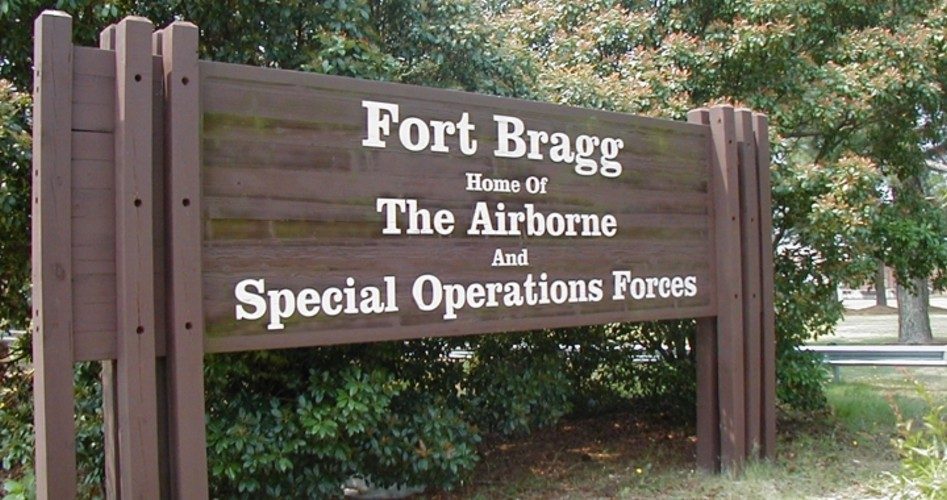
Having recently released a list of 1,500 “Confederate monuments” that the Southern Poverty Law Center (SPLC) is demanding be taken down, the radical organization is now calling for renaming several army posts because they bear the name of a Confederate general. (Although sometimes called “bases,” army installations are known as “posts”; it is air force installations that are known as “bases.”)
And if they are not taken down, the SPLC predicts, there will be “more turmoil and bloodshed.”
The SPLC has even posted the names of elementary and middle schools across the country that must be renamed, causing some alarm that such an irresponsible listing could precipitate violence that could involve little children. Some far-left agitators such as Antifa have suggested that since the police won’t shut down what they call fascists, they will have to do it themselves.
Eight U.S. army posts use the names of a Confederate general, including Fort Bragg in North Carolina (home of the 82nd Airborne division); Fort Hood in Texas; and Fort Benning in Georgia.
Fort Bragg was named for General Braxton Bragg, who commanded the Confederate “Army of Tennessee,” who won the Battle of Chickamauga in northern Georgia, but subsequently blundered away Confederate control of the city of Chattanooga (an important rail center), leading to his removal by Confederate President Jefferson Davis in 1863.
Fort Hood was named for General John Bell Hood, who had a reputation as one of the best brigade and division commanders in the Confederate army. He lost use of his arm during the Battle of Gettysburg in 1863, and then suffered a severe leg wound at Chickamauga, which led to its amputation. Despite these injuries, he led the Army of Tennessee in the famous Confederate defeat at the Battle of Franklin on November 30, 1964, which combined with an ill-advised assault upon Nashville soon after essentially destroyed the army.
Fort Benning was named for General Henry Lewis Benning, who had been a legislator and a member of the Supreme Court in Georgia, before commanding “Benning’s Brigade” in the war.
Other posts named for Confederate generals include Fort Gordon, Fort Lee, Fort A.P. Hill, Fort Polk, and Fort Rucker.
The Department of Defense has said they will not even consider renaming any of the posts.
Why did the U.S. Army choose to name several army posts after Confederate generals? The answer can be traced back to the sentiment expressed by President Abraham Lincoln in his second inaugural address, delivered on March 4, 1865, when it was clear that the Southern Confederacy was collapsing. Lincoln called for reconciliation, saying, “With malice toward none, with charity for all, with firmness in the right as God gives us to see the right, let us strive on to finish the work we are in, to bind up the nation’s wounds, to care for him who shall have borne the battle and for his widow and his orphan, to do all which may achieve and cherish a just and lasting peace among ourselves and with all nations.”
In short, it was determined among those in the victorious North that nothing was to be gained by verbally castigating the defeated foe. When General Robert E. Lee surrendered what was left of the Army of Northern Virginia, on April 9, 1865, General U.S. Grant forbade celebrating by his soldiers in Lee’s presence. “They are our countrymen again,” Grant advised them.
In other words, they wanted the country to reconcile. This was the prevailing view when it was decided that U.S. army posts in the former Confederacy be named after Confederate soldiers. It was a noble gesture — and a wise one.
Unfortunately, far too many politicians today appear to be more influenced by scoring cheap political points by trashing these generals, or they are too timid to stand up to the politically-inspired attacks upon them. And, of course, the ultimate goal is not Confederate generals, anyway. Once the precedent is established by attacking men that many are afraid to defend, lest they be accused of being “pro-slavery,” or at least “insensitive,” the cultural subverters will then move on to the Founding Fathers — men such as George Washington, Thomas Jefferson, and James Madison. This brings the subverters to the ultimate goal of chipping away at the foundations of the country, including the Declaration of Independence and the Constitution, which will be disparaged as archaic documents hopelessly tainted by slavery and bigotry.
The cultural subverters will then propose to replace our Constitution with a “social democracy,” by which they really mean a Marxist regime. This Taliban-like assault will not end until Americans make it clear to their elected representatives that we will not tolerate these continued attacks upon American heritage. Marxists always use existing divisions in society (or create them) to advance their goals, and the present campaign to attack Confederate monuments is really no different.
Photo of Fort Bragg sign: Wikimedia Commons
Steve Byas is the author of History’s Greatest Libels, which challenges unfair attacks upon certain individuals in history, including Christopher Columbus, Thomas Jefferson, Marie Antoinette, and Clarence Thomas.



